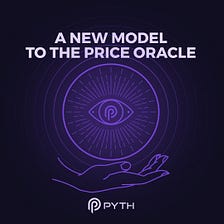The Pyth Network, a notable oracle network specializing in real-time price data, has made significant strides in the financial technology sector. Providing over 300 live price feeds, it spans various asset classes including digital currencies, stocks, ETFs, foreign exchange, and commodities. This network has gained prominence thanks to its collaboration with leading exchanges, market makers, and financial institutions, all contributing proprietary pricing information for on-chain aggregation and dissemination.
What sets the Pyth Network apart is its innovative pull oracle design, enabling applications to seamlessly retrieve the latest pricing data on their native blockchain platforms. You won’t be wrong by thinking that Chainlink is somewhat similar, but this is where PYTH has the upper hand, which we’ll cover shortly.
Since its establishment, the Pyth Network has garnered more than $1 billion in total value and bolstered DeFi protocols that have managed over $70 billion in trading volume. Its influence extends to over 200 applications. The network functions by collecting price data from various sources, which is then consolidated by the Pyth Oracle program into a unified price and confidence interval. This data is then made available to decentralized applications (dApps) across different blockchains.
The network’s native token, PYTH, experienced a staggering 826% surge since its introduction in the market on November 20, reaching its peak just four days later. This increase was mostly observed on its launch day, followed by a gradual rise and a subsequent 30% correction.
As 2023 progresses, the big question is whether PYTH has reached its zenith for the year, or if there’s potential for further price growth. Let’s find out!
PYTH Price Dynamics
Analyzing the limited historical data, the focus is on the 15-minute trading chart of PYTH. Initially, a sharp price spike is observed, typical of a new token release. This was followed by a brief stabilization phase, with prices fluctuating between $0.37 and $0.28, concluding on November 21.
Subsequently, a significant uptrend took shape, following a five-wave pattern. Upon reaching its apex, a correction occurred, bringing the price of PYTH to down to $0.39, the 0.618 Fibonacci level. According to Elliott Wave theory, this level often marks the end of the initial correction phase, suggesting potential for further price escalation beyond its recent high.
However, the subsequent uptrend lacked vigor, with only a modest increase peaking at $0.45 before declining again. Currently, the price has dipped below its ascending support level, signaling a need for caution.
Optimistic Outlook
In this scenario, the initial price movements form part of a larger five-wave impulse pattern, with the third wave’s second sub-wave currently unfolding. If this holds true, the price of PYTH on major exchanges like Gate.io is poised for a significant surge in its third wave, aiming for the optimal Fibonacci extension level of 1.618 at $0.81.
This would represent a 75% increase from current levels, which goes in line with the forecast of PYTH price. Post wave 4 consolidation, another peak is anticipated, potentially reaching just below $1. This bullish perspective would be negated if the price continues its current downtrend, falling below $0.40.
Pessimistic Scenario
In this alternate view, the price’s recent recovery to the 0.382 Fibonacci retracement level, following its all-time high, is deemed a minor rebound. This suggests that the larger corrective phase post-high is still in progress, potentially allowing for an upward move to around $0.50, only to then reverse into a deeper decline.
This downturn could lead to new lows, potentially around the $0.37 level, the initial consolidation resistance. A decline to this level would set the stage for a larger upward trend, aligning with the optimistic scenario’s third wave.
The Big PYTH Fundraise
The Pyth Data Association, a Swiss-based non-profit organization dedicated to advancing the Pyth platform, disclosed that it successfully secured investments from a group of distinguished entities in the crypto realm. This group includes Castle Island Ventures, Multicoin Capital, Wintermute Ventures and more.
Michael Cahill, the chief executive of Duoro Labs, the developer behind Pyth, and a director at the Pyth Data Association, shared insights in a recent interview. He revealed that the new partners have been granted allocations of PYTH tokens, which serve a dual purpose: as assets and as voting rights within the protocol’s governance framework. However, Cahill chose not to disclose the total funds raised in this round. The implication is that these new backers, armed with their PYTH tokens, could potentially exert significant influence over the future direction and development of the Pyth platform.
Pyth, which made its debut on the Solana blockchain in 2021 and has since expanded across 45 different blockchains, currently supports a quarter of all applications that utilize oracle services, as per Cahill’s statements. Oracles play a vital role in blockchain ecosystems, acting as conduits for real-world data. In Pyth’s case, this includes pricing information for various assets such as stocks, commodities, and currencies, encompassing both traditional fiat and cryptocurrencies.
Distinguishing itself from Chainlink, the current front-runner in the oracle space, Pyth differentiates its approach by sourcing data directly from primary financial firms, many of which are leading players in the trading sector. This method of sourcing data directly, along with other aspects of Pyth’s architecture, is intended to provide the protocol with a competitive edge, particularly in terms of speed. This advantage is seen as crucial in Pyth’s strategy to challenge Chainlink’s market dominance and to align the often lagging crypto markets more closely with the fast-paced demands of contemporary finance.
Conclusion
Given PYTH’s brief price history, making reliable long-term forecasts is challenging. However, current trends on the 15-minute chart suggest a short-term price increase, with potential to reach or surpass $0.50. A continued upward trajectory beyond this point could bolster the optimistic scenario, hinting at new record highs.
In either case, if the price further declines past $0.40, it would challenge these projections, necessitating a reevaluation once the current downtrend concludes.
Resources:
Become Pythian: https://linktr.ee/PythNetwork
Telegram: https://t.me/Pyth_Network
Updates: https://t.me/PythAnnouncements
Website: https://pyth.network

